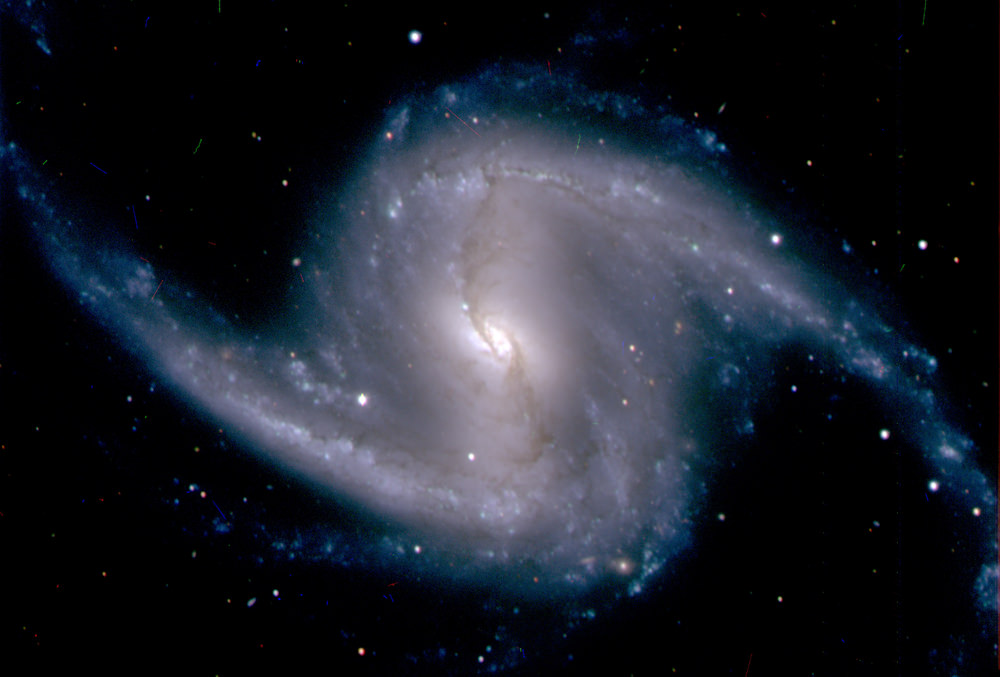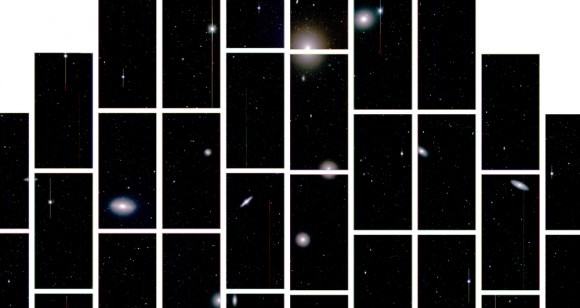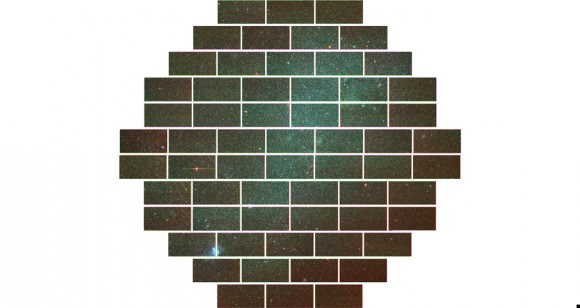Zoomed-in image from the Dark Energy Camera of the barred spiral galaxy NGC 1365, about 60 million light-years from Earth. (Dark Energy Survey Collaboration)
The ongoing search for dark energy now has a new set of eyes: the Dark Energy Camera, mounted on the 4-meter Victor M. Blanco telescope at the National Science Foundation’s Cerro Tololo Inter-American Observatory in Chile. The culmination of eight years of planning and engineering, the phone-booth-sized 570-megapixel Dark Energy Camera has now gathered its very first images, capturing light from cosmic structures tens of millions of light-years away.
Eventually the program’s survey will help astronomers uncover the secrets of dark energy — the enigmatic force suspected to be behind the ongoing and curiously accelerating expansion of the Universe.
Zoomed-in image from the Dark Energy Camera of the Fornax cluster
“The Dark Energy Survey will help us understand why the expansion of the universe is accelerating, rather than slowing due to gravity,” said Brenna Flaugher, project manager and scientist at Fermilab.
Read more: Polar Telescope Casts New Light on Dark Energy
The most powerful instrument of its kind, the Dark Energy Camera will be used to create highly-detailed color images of a full 1/8th of the night sky — about 5,000 square degrees — surveying thousands of supernovae, galactic clusters and literally hundreds of millions of galaxies, peering as far away as 8 billion light-years.
The survey will attempt to measure the effects of dark energy on large-scale cosmic structures, as well as identify its gravitational lensing effects on light from distant galaxies. The images seen here, acquired on September 12, 2012, are just the beginning… the Dark Energy Survey is expected to begin actual scientific investigations this December.
Full Dark Energy Camera composite image of the Small Magellanic Cloud
“The achievement of first light through the Dark Energy Camera begins a significant new era in our exploration of the cosmic frontier,” said James Siegrist, associate director of science for high energy physics with the U.S. Department of Energy. “The results of this survey will bring us closer to understanding the mystery of dark energy, and what it means for the universe.”
Read more on the Symmetry Magazine article here, and you can also follow the Dark Energy Survey on Facebook here. (The Fermilab press release can be found here.)
Images: Dark Energy Survey Collaboration. Inset image: the 4-meter Blanco Telescope dome at CTIO (NOAO)
The Dark Energy Survey is supported by funding from the U.S. Department of Energy; the National Science Foundation; funding agencies in the United Kingdom, Spain, Brazil, Germany and Switzerland; and the participating DES institutions.




Dark energy means many instances such as; Allah, God, Nature,
Single dimension, Super power, Black body, Big or minimal black hole, A
black hole, Primordial black hole, Borders on the spiritual, Ultimate
reality, Huge reserve of the natural force, Primordial whole and
eternity present, Absolute zero space-time and physics. & so on. Reality of Creator or Dark energy can be found at http://bit.ly/aASjyV
They need to aim those telescopes in the COMA Galaxy…NGC 4555 in the constellation of Virgo…
I always wonder what the Universe is expanding into? I know it is like a balloon and it gets bigger as you blow it up, but something has to be outside of the boundary.
It’s expanding into the space it creates as it expands. *boggle*
Now that hurts my temples…..
Think of the universe as a flat space that is infinite. What happens is that this evolves in time, thus giving spacetime, such that every point in the space separates by an exponential function ~ e^{at}. Matter in this space then rides along with this separation.
LC
I’ve always wondered how many universes there are? Why not an infinite number of them? Try to visualize THAT and you’ll put a new crease in your cerebral cortex?
Now THAT’s a camera – 570-megapixels! WOWIE and YIKES! Makes my little desk top computer whimper and smoke… By way of comparison, the Kepler mission camera is relatively small at 95 megapixels ~ Yah gotta like this instrument! Please keep us updated Jason.
Very exciting “hunting”. When the future “mining” of the hunter is unknown now. Black cat in a dark room?
The Coma Cluster of Galaxies is a HUGE group with one of the highest densities of galaxies known, a ‘super cluster’. http://apod.nasa.gov/apod/ap100502.html Recently even larger clusters have been discovered which put the Coma Cluster more into the LARGE but not the biggest grouping of galaxies.
You may be referring to M87 which is assumed to be the largest galaxy in the Coma Cluster? M87 is a giant elliptical and is known for humongous jets of plasma which extend presumably from a gigantic Black Hole in it’s core, thousands of light years into space! This galaxy and cluster are found in the constellation Coma Berenices. http://en.wikipedia.org/wiki/Coma_Berenices
NGC 4555 is also pretty huge as galaxies go, and is a solitary elliptical some 125,000 light years across. This galaxy is relatively isolated and not associated with the Coma Cluster. What stands out about NGC 4555 is the gigantic envelope of hot gas that surrounds it and emits copious x-rays.. as observed by the Chandra X-ray Telescope. http://arxiv.org/pdf/astro-ph/0407552.pdf
Aqua4U…Take a look at ABELL 2151 in the Herc.
So many galactic clusters , so few Bortle 1 skies.
Thanks, I will! I am in the process of building a 12 1/2″ Newt… when it is finished (almost done) I plan on spending next spring somewhere FAR, far out thar! At present, I have a 4″ Meade S/C and a 60mm refractor that I’ve turned into a solar observation scope. The 4″ is okay for the brighter/closer galaxies like M51, M31, the Leo Trio etc., but most appear as just smudges of light…. I had access to a 24″ Dob. for a while there and got SO spoiled!
Aqua, I think you got your galaxy clusters confused. M87 in a member of the nearby Virgo Cluster (and is located in the constellation Virgo!): http://en.wikipedia.org/wiki/Messier_87
The Virgo and Coma clusters are located close to each other in the sky though.
You are absolutely right! I got NGC 4555 mixed up with M87? Thanks for the head’s up!